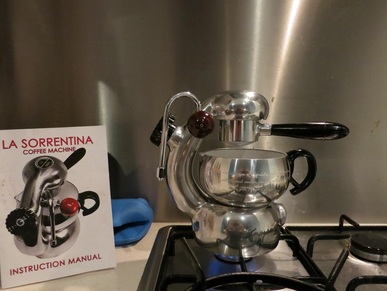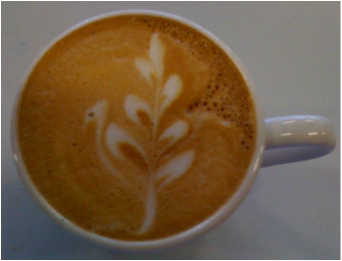
For those that don't know, La Sorrentina is an Italian coffee maker, reproducing the 1946 'Atomic' design by Milanese designer Giordano Robbiati. It's occasionally denigrated as merely a high-class Moka pot, but is actually far better. Able to reach around 5 bar of pressure, it's possible to get a reasonable crema and excellent steam volume.
However, despite these strengths she's even more temperamental than the infamous Miss Silvia, and making a decent espresso requires a series of tricks, none of which are detailed in the manual. There's a few videos on YouTube (this one is terrible and you can do far better, this one is better but doesn't explain how he got there), but not much by way of a technical description. I hope this post goes some way to fill that gap.
- Fill the jug with the right amount of cold water.
- Pour into the boiler and tighten the black cap.
- Grind your coffee beans to the right fineness and put the right amount in the group handle.
- Pack it down with the right amount of force.
- Ensure the red milk valve is closed.
- Place the unit on the heat source with the right amount of heat.
- Wait the right amount of time for coffee to pour.
- Froth/heat the milk.
- Turn off the heat source.
- Pour the coffee into a cup and add milk.
- Open the steam valve and wait until it stops producing.
- Remove the group handle, clean it, then empty the remaining water from the boiler.
Here's tip #1 - throw away your first ten coffees. They will not be worth drinking, and you'll end up thinking it's a bad machine. It's not, it just takes a bit more care and attention than most.
The process to get a drinkable coffee is a bit more involved - not harder - just more involved.
The right amount of water is easy enough to find. When you empty the remaining water in step 12 of the basic process, empty it into the (cleaned!) coffee jug. Mark this level with a permanent marker or scratch. This is the minimum quantity of water you need. If you're making one espresso, add a 30mL shot more water. Add a dash more (maybe another 15mL if you want to be precise) for the steam. Two espressos, two shots, etc. Any water you add above this minimum will end up pouring through as coffee or get turned into steam. For a single shot of espresso, this extra ends up being about 2mm above the mark I made, and roughly halfway up the jug.
The right amount of coffee is also easy - however much you can fit in the damn portafilter! Yes, this is far more than the manual recommends. Yes, you'll be "wasting" coffee. Shut up. It'll taste better. Trust me.
The right amount of force is also easy. Work out how hard you intend to press down with your tamper, and be consistent. (Experts recommend 15N of force. Unfortunately, my arm doesn't come with a spring balance inbuilt.) That's it. This is now the "right amount" of force - it's right for you, and that's good enough.
The right grind is more difficult, and you will have to experiment. It is nowhere near the "medium coarse" suggested by the manual. It is much closer to "almost as fine as your grinder can get". The best strategy for finding the sweet spot is Isaac Newton's "halving the interval" method:
Start at the coarsest espresso setting and make a coffee. It'll almost certainly be weak, thin, and foul smelling. Move to the finest espresso setting. Make sure you've very firmly attached the group handle to the machine. At this fineness, it'll almost certainly blow the pressure release valve before any coffee pours at all, and you definitely want the valve to blow instead of the entire group handle flying off the machine! (Here's tip #2 - always remember to open the steam valve before removing the group handle. You'll probably have to learn this the hard way too. Trust me, you won't do it twice...) Turn the heat off, open the steam valve fully, and walk away. When the machine is cool and ready for you to try again, split the difference. If it's still weak, split again in the finer direction. If it's still blowing the pressure release, split again in the coarser direction. Repeat until you've found the sweet spot.
This description makes it sound like you'll just know the sweet spot when you see it. Chances are, you'll have a rough idea but so many gradations on your grinder that there's two or three that are all reasonable. Here's tip #3 - the sweet spot is when the pressure release valve does blow, but only after most of the coffee has already poured. Why? Well the first part of the coffee extraction process releases medium-thick, black coffee. Very aromatic, but not the best bit. What you're really after is the brown, very thick crema that comes second. Since this is thicker and less viscous, the pressure in the group head has to increase a bit more to force it out. So you're looking for the early stage pressure to be below the limit, and the later stage to be just above. The machine will be fine with this, but you should ideally be turning the heat off within 15-20 seconds or so of the valve blowing, even if you're busy frothing milk. Be aware that the machine will now be fucking hot. That's a technical term for "don't touch the metal bits."
The right amount of time is easy enough, as it's related to the right grind. From cold water you can expect it to take 5 to 7 minutes. From just boiled (my recommendation) expect around 3 to 4 minutes. You should turn off the heat before what's pouring out is no longer crema but weak thin watery coffee. Sometimes you'll get good crema after a bunch of big oily bubbles, but usually these bubbles are a sign that the crema is ending. In the ideal world the crema will pour as a thin stream, perhaps curling in on itself like a pig's tail. You'll then remove the jug, (replace it with another or a cloth - what pours out now is horrible and will foul your coffee), texture your milk, and turn the heat off either as you remove the jug or in the middle of the milk frothing process. There should be enough steam to make one person's worth of milk with the heat off, but you may need to leave it on for some of the time if making milk for two or more people.
- Water - the quantity of poured coffee you want above the line marked by filling the jug with the leftover water from a previous pour.
- Coffee - as much as possible.
- Force - around 15N, but whatever you can do consistently. Hard, but don't put your back into it.
- Grind - as fine as possible such that the pressure release valve doesn't blow until after some crema has started to pour.
- Time - stop before you reach thin watery coffee, usually just after big oily bubbles start to pour.
- Heat - a medium sized gas hob on max. Don't let the flames shoot past the bottom of the machine. I don't have an electric stove, but I'd expect this to be equivalent to 60-80% of the full heat. You'll certainly want to pre-heat the stove if it's electric.
- Throw away your first ten coffees. La Sorrentina requires a bit of experimentation to master, but can make a good espresso if you persist.
- Always open the steam valve and wait until it stops steaming before you ever remove the group handle. This releases any remaining pressure in the machine, and you will certainly know about it should you ever forget.
- The sweet spot for your grind is just fine enough that the pressure release valve usually blows, but only after some crema has started to pour.
- To avoid your crema dissipating in the jug, don't rest the jug directly on the flat metal of the boiler but instead either hold it (this gets tedious) or put a heat proof mat between them. Much of the crema disappears because the high heat required to produce it also means the jug heats up so much that it dissolves while you're collecting it.
- Remove the jug once the crema has poured. Any coffee that emerges after this will be over-extracted and bitter. You'll need either a cloth or a second jug to catch the dregs.
- Start with just boiled water. It's faster (unless your kettle is inefficient!) and makes no discernible difference to the quality of the coffee.

7/10 is pretty damn good for a $400 single-boiler machine. La Sorrentina can make a decent coffee.
 RSS Feed
RSS Feed